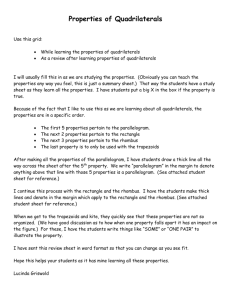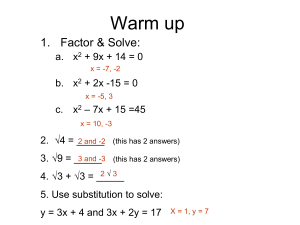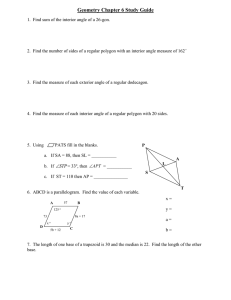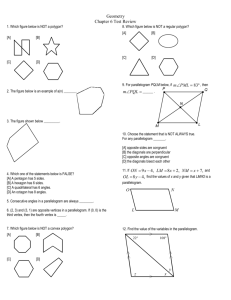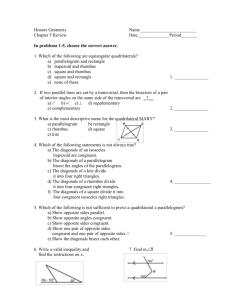6.4 Rhombuses, Rectangles and Squares
advertisement
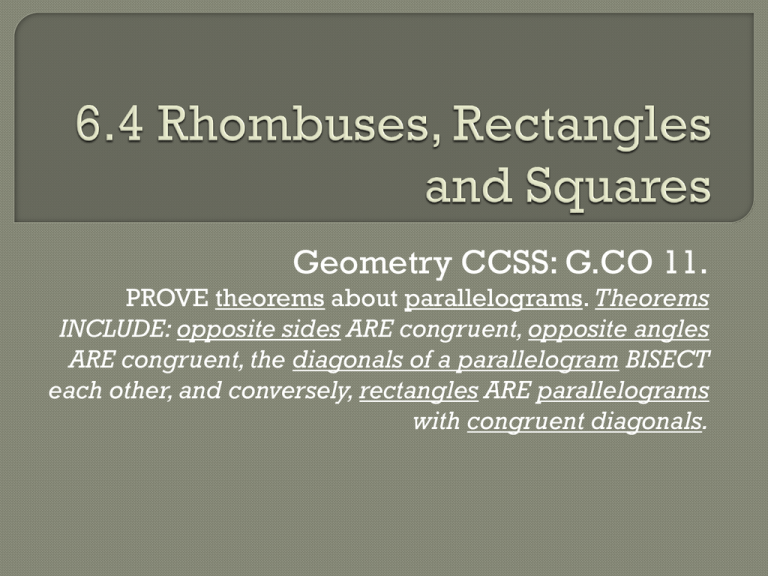
Geometry CCSS: G.CO 11. PROVE theorems about parallelograms. Theorems INCLUDE: opposite sides ARE congruent, opposite angles ARE congruent, the diagonals of a parallelogram BISECT each other, and conversely, rectangles ARE parallelograms with congruent diagonals. What are the properties of different quadrilaterals? How do we use the formulas of areas of different quadrilaterals to solve real-life problems? Now a little review: 11 PROVE theorems about parallelograms. Theorems INCLUDE: opposite sides ARE congruent, opposite angles ARE congruent, the d 1. Make sense of problems and persevere in solving them. 2. Reason abstractly and quantitatively. 3. Construct viable arguments and critique the reasoning of others. 4. Model with mathematics. 5. Use appropriate tools strategically. 6. Attend to precision. 7. Look for and make use of structure. 8. Look for and express regularity in repeated reasoning. 60 120 120 6 6 50° 130° Test your prior knowledge and try to fill in the chart with properties of the following quadrilaterals: Rectangle Rhombus Square Properties Properties Properties Use properties of sides and angles of rhombuses, rectangles, and squares. Use properties of diagonals of rhombuses, rectangles and squares. What are properties of sides and angles of rhombuses, rectangles, and squares? In this lesson, you will study three special types of parallelograms: rhombuses, rectangles and squares. A rectangle is a parallelogram with four right angles. A rhombus is a parallelogram with four congruent sides A square is a parallelogram with four congruent sides and four right angles. Each shape has the properties of every group that it belongs to. For instance, a square is a rectangle, a rhombus and a parallelogram; so it has all of the properties of those shapes. parallelograms rhombuses rectangles squares Rhombuses Rectangles Some examples of a rhombus a. b. Decide whether the statement is always, sometimes, or never true. A rhombus is a rectangle. A parallelogram is a rectangle. parallelograms rhombuses rectangles squares Rhombuses Rectangles a. Decide whether the statement is always, sometimes, or never true. A rhombus is a rectangle. The statement is sometimes true. In the Venn diagram, the regions for rhombuses and rectangles overlap. IF the rhombus is a square, it is a rectangle. parallelograms rhombuses rectangles squares Rhombuses Rectangles b. Decide whether the statement is always, sometimes, or never true. A parallelogram is a rectangle. The statement is sometimes true. Some parallelograms are rectangles. In the Venn diagram, you can see that some of the shapes in the parallelogram box are in the area for rectangles, but many aren’t. parallelograms rhombuses rectangles squares Rhombuses Rectangles ABCD is a rectangle. What else do you know about ABCD? Because ABCD is a rectangle, it has four right angles by definition. The definition also states that rectangles are parallelograms, so ABCD has all the properties of a parallelogram: • Opposite sides are parallel and congruent. • Opposite angles are congruent and consecutive angles are supplementary. • Diagonals bisect each other. A rectangle is defined as a parallelogram with four right angles. But any quadrilateral with four right angles is a rectangle because any quadrilateral with four right angles is a parallelogram. Corollaries about special quadrilaterals: • Rhombus Corollary: A quadrilateral is a rhombus if and only if it has four congruent sides. • Rectangle Corollary: A quadrilateral is a rectangle if and only if it has four right angles. • Square Corollary: A quadrilateral is a square if and only if it is a rhombus and a rectangle. • You can use these to prove that a quadrilateral is a rhombus, rectangle or square without proving first that the quadrilateral is a parallelogram. Characteristics Both pairs of opposite sides parallel Diagonals are congruent Both pairs of opposite sides congruent At least one right angle Both pairs of opposite angles congruent Exactly one pair of opposite sides parallel Diagonals are perpendicular All sides are congruent Consecutive angles congruent Diagonals bisect each other Diagonals bisect opposite angles Consecutive angles supplementary Parallelogram Rectangle Rhombus Square In the diagram at the right, PQRS is a rhombus. What is the value of y? P Q 2y + 3 S 5y - 6 All four sides of a rhombus are ≅, so RS = PS. 5y – 6 = 2y + 3 Equate lengths of ≅ sides. 5y = 2y + 9 Add 6 to each side. 3y = 9 Subtract 2y from each side. y=3 Divide each side by 3. R The following theorems are about diagonals of rhombuses and rectangles. Theorem 6.11: A parallelogram is a rhombus if and only if its diagonals are perpendicular. ABCD is a rhombus if and only if AC BD. Theorem 6.12: A parallelogram is a rhombus if and only if each diagonal bisects a pair of opposite angles. ABCD is a rhombus if and only if AC bisects DAB and BCD and BD bisects ADC and CBA. Theorem 6.13: A parallelogram is a rectangle if and only if its diagonals are congruent. ABCD is a rectangle if and only if AC ≅ BD. A B D C You can rewrite Theorem 6.11 as a conditional statement and its converse. Conditional statement: If the diagonals of a parallelogram are perpendicular, then the parallelogram is a rhombus. Converse: If a parallelogram is a rhombus, then its diagonals are perpendicular. A B X Statements: 1. ABCD is a rhombus 2. AB ≅ CB 3. AX ≅ CX 4. BX ≅ DX 5. ∆AXB ≅ ∆CXB 6. AXB ≅ CXB 7. AC BD Reasons: 1. Given D C A B X D Statements: 1. ABCD is a rhombus 2. AB ≅ CB 3. AX ≅ CX 4. BX ≅ DX 5. ∆AXB ≅ ∆CXB 6. AXB ≅ CXB 7. AC BD Reasons: 1. Given 2. Given C A B X D Statements: 1. ABCD is a rhombus 2. AB ≅ CB 3. AX ≅ CX 4. BX ≅ DX 5. ∆AXB ≅ ∆CXB 6. AXB ≅ CXB 7. AC BD C Reasons: 1. Given 2. Given 3. Def. of . Diagonals bisect each other. A B X D Statements: 1. ABCD is a rhombus 2. AB ≅ CB 3. AX ≅ CX 4. BX ≅ DX 5. ∆AXB ≅ ∆CXB 6. AXB ≅ CXB 7. AC BD C Reasons: 1. Given 2. Given 3. Def. of . Diagonals bisect each other. 4. Def. of . Diagonals bisect each other. A B X D Statements: 1. ABCD is a rhombus 2. AB ≅ CB 3. AX ≅ CX 4. BX ≅ DX 5. ∆AXB ≅ ∆CXB 6. AXB ≅ CXB 7. AC BD C Reasons: 1. Given 2. Given 3. Def. of . Diagonals bisect each other. 4. Def. of . Diagonals bisect each other. 5. SSS congruence post. A B X Statements: 1. ABCD is a rhombus 2. AB ≅ CB 3. AX ≅ CX 4. BX ≅ DX 5. ∆AXB ≅ ∆CXB 6. AXB ≅ CXB 7. AC BD D C Reasons: 1. Given 2. Given 3. Def. of . Diagonals bisect each other. 4. Def. of . Diagonals bisect each other. 5. SSS congruence post. 6. CPCTC A B X D Statements: 1. ABCD is a rhombus 2. AB ≅ CB 3. AX ≅ CX 4. BX ≅ DX 5. ∆AXB ≅ ∆CXB 6. AXB ≅ CXB 7. AC BD C Reasons: 1. Given 2. Given 3. Def. of . Diagonals bisect each other. 4. Def. of . Diagonals bisect each other. 5. SSS congruence post. 6. CPCTC 7. Congruent Adjacent s Assign coordinates. Because AC BD, place ABCD in the coordinate plane so AC and BD lie on the axes and their intersection is at the origin. Let (0, a) be the coordinates of A, and let (b, 0) be the coordinates of B. Because ABCD is a parallelogram, the diagonals bisect each other and OA = OC. So, the coordinates of C are (0, - a). Similarly the coordinates of D are (- b, 0). A(0, a) D(- b, 0) B(b, 0) C(0, - a) Find the lengths of the sides of ABCD. Use the distance formula (See – you’re never going to get rid of this) AB=√(b – 0)2 + (0 – a)2 = √b2 + a2 BC= √(0 - b)2 + (– a - 0)2 = √b2 + a2 CD= √(- b – 0)2 + [0 - (– a)]2 = √b2 + a2 DA= √[(0 – (- b)]2 + (a – 0)2 = √b2 + A(0, a) D(- b, 0) B(b, 0) C(0, - a) a2 All the side lengths are equal, so ABCD is a rhombus. 4 feet a. b. CARPENTRY. You are building a rectangular frame for a theater set. First, you nail four pieces of wood together as shown at the right. What is the shape of the frame? To make sure the frame is a rectangle, you measure the diagonals. One is 7 feet 4 inches. The other is 7 feet 2 inches. Is the frame a rectangle? Explain. 6 feet 6 feet 4 feet 4 feet a. First, you nail four pieces of wood together as shown at the right. What is the shape of the frame? 6 feet 6 feet Opposite sides are congruent, so the frame is a parallelogram. 4 feet 4 feet To make sure the frame is a rectangle, you measure the diagonals. One is 7 feet 4 inches. The other is 7 feet 2 inches. Is the frame a rectangle? Explain. The parallelogram is NOT a rectangle. If it were a rectangle, the diagonals would be congruent. b. 6 feet 6 feet 4 feet You’ve just had a new door installed, but it doesn’t seem to fit into the door jamb properly. What could you do to determine if your new door is rectangular? 1. Take out a piece of notebook paper and make a hot dog fold over from the right side over to the pink line. The fold crease 2. Now, divide the right hand section into 5 sections by drawing 4 evenly spaced lines. 3. Use scissors to cut along your drawn line, but ONLY to the crease! 4. Write QUADRILATERALS down the left hand side The fold crease 5. Fold over the top cut section and write PARALLELOGRAM on the outside. 6. Reopen the fold. The fold crease 7. On the left hand section, draw a parallelogram. 8. On the right hand side, list all of the properties of a parallelogram. 1. Opposite angles are congruent. 2. Consecutive angles are supplementary. 3. Opposite sides are congruent. 4. Diagonals bisect each other. 5. Opposite sides are parallel * Fold over the second cut section and write RECTANGLE on the outside. * Reopen the fold. 1. Opposite angles are congruent. 2. Consecutive angles are supplementary. 3. Opposite sides are congruent. 4. Diagonals bisect each other. 5. Opposite sides are parallel * On the left hand section, draw a rectangle. 1. Opposite angles are congruent. 2. Consecutive angles are supplementary. 3. Opposite sides are congruent. 4. Diagonals bisect each other. 5. Opposite sides are parallel 1. Special parallelogram. * On the right hand side, list all of the properties of a rectangle. 2. Has 4 right angles 3. Diagonals are congruent. * Fold over the third cut section and write RHOMBUS on the outside. 1. Opposite angles are congruent. 2. Consecutive angles are supplementary. 3. Opposite sides are congruent. 4. Diagonals bisect each other. 5. Opposite sides are parallel 1. Special parallelogram. 2. Has 4 right angles 3. Diagonals are congruent. * Reopen the fold. * On the left hand section, draw a rhombus. 1. Opposite angles are congruent. 2. Consecutive angles are supplementary. 3. Opposite sides are congruent. 4. Diagonals bisect each other. 5. Opposite sides are parallel 1. Special parallelogram. * On the right hand side, list all of the properties of a rhombus. 2. Has 4 right angles 3. Diagonals are congruent. 1. Special Parallelogram 2. Has 4 Congruent sides 3. Diagonals are perpendicular. 4. Diagonals bisect opposite angles * Fold over the third cut section and write SQUARE on the outside. 1. Opposite angles are congruent. 2. Consecutive angles are supplementary. 3. Opposite sides are congruent. 4. Diagonals bisect each other. 5. Opposite sides are parallel 1. Special parallelogram. 2. Has 4 right angles 3. Diagonals are congruent. * Reopen the fold. 1. Special Parallelogram 2. Has 4 Congruent sides 3. Diagonals are perpendicular. 4. Diagonals bisect opposite angles * On the left hand section, draw a square. 1. Opposite angles are congruent. 2. Consecutive angles are supplementary. 3. Opposite sides are congruent. 4. Diagonals bisect each other. 5. Opposite sides are parallel 1. Special parallelogram. * On the right hand side, list all of the properties of a square. * Place in your notebook and save for tomorrow. 2. Has 4 right angles 3. Diagonals are congruent. 1. Special Parallelogram 2. Has 4 Congruent sides 3. Diagonals are perpendicular. 4. Diagonals bisect opposite angles 1. All the properties of parallelogram, rectangle, and rhombus 2. 4 congruent sides and 4 right angles Name the figure described. 1. 2. 3. A quadrilateral that is both a rhombus and a rectangle. A quadrilateral with exactly one pair of parallel sides. A parallelogram with perpendicular diagonals What are the properties of different quadrilaterals? How do we use the formulas of areas of different quadrilaterals to solve real-life problems? What are some properties of trapezoids and kits? Use properties of trapezoids. Use properties of kites. A trapezoid is a quadrilateral with exactly one pair of parallel sides. The parallel sides are the bases. A trapezoid has two pairs of base angles. For instance in trapezoid ABCD D and C are one pair of base angles. The other pair is A and B. The nonparallel sides are the legs of the trapezoid. A base leg leg D B base C If the legs of a trapezoid are congruent, then the trapezoid is an isosceles trapezoid. Theorem 6.14 If a trapezoid is isosceles, then each pair of base angles is congruent. A ≅ B, C ≅ D A D B C Theorem 6.15 If a trapezoid has a pair of congruent base angles, then it is an isosceles trapezoid. D ABCD is an isosceles trapezoid A B C Theorem 6.16 A trapezoid is isosceles if and only if its diagonals are congruent. ABCD is isosceles if and only if AC ≅ BD. A D B C The midsegment of a trapezoid is the B segment that connects the midpoints of its legs. Theorem 6.17 is A similar to the Midsegment Theorem for triangles. C midsegment D The midsegment of a trapezoid is parallel to each base and its length is one half the sums of the lengths of A the bases. MN║AD, MN║BC MN = ½ (AD + BC) B M C N D LAYER CAKE A baker is making a cake like the one at the right. The top layer has a diameter of 8 inches and the bottom layer has a diameter of 20 inches. How big should the middle layer be? the midsegment theorem for trapezoids. DG = ½(EF + CH)= ½ (8 + 20) = 14” E Use D C F G D A kite is a quadrilateral that has two pairs of consecutive congruent sides, but opposite sides are not congruent. Theorem 6.18 If a quadrilateral is a kite, then its diagonals are perpendicular. AC BD C B D A Theorem 6.19 If a quadrilateral is a kite, then exactly one pair of opposite B angles is congruent. A ≅ C, B ≅ D C D A WXYZ is a kite so the diagonals are perpendicular. You can use the W Pythagorean Theorem to find the side lengths. WX = √202 + 122 ≈ 23.32 XY = √122 + 122 ≈ 16.97 Because WXYZ is a kite, WZ = WX ≈ 23.32, and ZY = XY ≈ 16.97 X 12 20 U 12 12 Z Y J Find mG and mJ in the diagram at the H 132° 60° right. SOLUTION: GHJK is a kite, so G ≅ J and mG = mJ. G K 2(mG) + 132° + 60° = 360°Sum of measures of int. s of a quad. is 360° 2(mG) = 168°Simplify mG = 84° Divide each side by 2. So, mJ = mG = 84° Quadrilaterals 4-sided polygons Trapezoids 1. one pair of opposite sides Parallelograms Kites 1. 2 pairs of opposite sides 1. two pairs of 2. 2 pairs of opposite sides consecutive sides 3. 2 pairs of opposite angles 2. diagonals are 4. consecutive angles are supplementary 5. diagonals bis ect each other 3. one pair of opposite angles 2. midsegment p arallel to both b ases and average length of the bases Isosceles Trapezoids 1. legs are congruent Rhombus 1. 4 sides 2. base angles are congruent 2. diagonals are 3. diagonals are congruent Rectangle 1. 4 right angles 2. diagonals are congruent 3. diagonals bisect a pair of opposite angles Square 1. combination of rectangle and rhombus Geometry 11 PROVE theorems about parallelograms. Theorems INCLUDE: opposite sides ARE congruent, opposite angles ARE congruent, the d 1. Make sense of problems and persevere in solving them. 2. Reason abstractly and quantitatively. 3. Construct viable arguments and critique the reasoning of others. 4. Model with mathematics. 5. Use appropriate tools strategically. 6. Attend to precision. 7. Look for and make use of structure. 8. Look for and express regularity in repeated reasoning. PROVE theorems about parallelograms. Theorems INCLUDE: opposite sides ARE congruent, opposite angles ARE congruent, the diagonals of a parallelogram BISECT each other, and conversely, rectangles ARE parallelograms with congruent diagonals. Name the figure: 1. a quadrilateral with exactly one pair of opposite angles congruent and perpendicular diagonals 2. a quadrilateral that is both a rhombus and a rectangle 3. a quadrilateral with exactly one pair of ll sides. 4. any ll’ogram with perpendicular diagonals. Identify special quadrilaterals based on limited information. Prove that a quadrilateral is a special type of quadrilateral, such as a rhombus or trapezoid. How do we simplify real life tasks, checking if an object is rectangular, rhombus, trapezoid, kite or other quadrilateral? Quadrilateral In this chapter, you have studied the seven special Trapezoid Kite Parallelogram types of quadrilaterals shown at the right. Notice Isosceles Rhombus Rectangle that each shape has all the trapezoid Square properties of the shapes linked above it. For instance, squares have the properties of rhombuses, rectangles, parallelograms, and quadrilaterals. Quadrilateral ABCD has at least one pair of opposite sides congruent. What kinds of quadrilaterals meet this condition? Parallelogram Rhombus Opposites sides are ≅. Opposite sides are congruent. All sides are congruent. All sides are congruent. Legs are congruent. When you join the midpoints of the sides of any quadrilateral, what special quadrilateral is formed? Why? A F E B D G H C A Solution: Let E, F, G, and H be the midpoints of the sides of any quadrilateral, E ABCD as shown. D If you draw AC, the Midsegment Theorem for H triangles says that FG║AC and EG║AC, so FG║EH. C Similar reasoning shows that EF║HG. So by definition, EFGH is a parallelogram. F B G When you want to prove that a quadrilateral has a specific shape, you can use either the definition of the shape as in example 2 or you can use a theorem. You have learned 3 ways to prove that a quadrilateral is a rhombus. You can use the definition and show that the quadrilateral is a parallelogram that has four congruent sides. It is easier, however, to use the Rhombus Corollary and simply show that all four sides of the quadrilateral are congruent. Show that the quadrilateral is a parallelogram and that the diagonals are perpendicular (Thm. 6.11) Show that the quadrilateral is a parallelogram and that each diagonal bisects a pair of opposite angles. (Thm 6.12) 8 K(2, 5)N(6, 3) = 4.47 cm Show KLMN is a rhombus Solution: You can use any of the M(2, 1)N(6, 3) = 4.47 cm L(-2, 3)M(2, 1) = 4.47 cm three ways described in the 6 L(-2, 3)K(2, 5) = 4.47 cm concept summary above. For instance, you could show that opposite sides have the same slope and that the diagonals are 4 perpendicular. Another way L(-2, 3) shown in the next slide is to prove that all four sides have the same 2 length. AHA – DISTANCE FORMULA If you want, look on pg. 365 for the whole explanation of the distance formula So, because LM=NK=MN=KL, KLMN is a rhombus. -2 K(2, 5) N(6, 3) M(2, 1) 5 A What type of quadrilateral is ABCD? Explain your reasoning. D 60° 120° 120° 60° B C A What type of quadrilateral is ABCD? Explain your reasoning. D 60° 120° 120° Solution: A and D are supplementary, but A and B are not. So, AB║DC, but AD is not parallel to BC. By definition, ABCD is a trapezoid. Because base angles are congruent, ABCD is an isosceles trapezoid 60° B C The diagonals of quadrilateral ABCD intersect at point N to produce four congruent segments: AN ≅ BN ≅ CN ≅ DN. What type of quadrilateral is ABCD? Prove that your answer is correct. First Step: Draw a diagram. Draw the diagonals as described. Then connect the endpoints to draw quadrilateral ABCD. B First Step: Draw a diagram. Draw the diagonals as described. Then connect the endpoints to draw quadrilateral ABCD. 2nd Step: Make a conjecture: • Quadrilateral ABCD looks like a rectangle. 3rd step: Prove your conjecture • Given: AN ≅ BN ≅ CN ≅ DN • Prove ABCD is a rectangle. C N A D Because you are given information about diagonals, show that ABCD is a parallelogram with congruent diagonals. First prove that ABCD is a parallelogram. • Because BN ≅ DN and AN ≅ CN, BD and AC bisect each other. Because the diagonals of ABCD bisect each other, ABCD is a parallelogram. Then prove that the diagonals of ABCD are congruent. • From the given you can write BN = AN and DN = CN so, by the addition property of Equality, BN + DN = AN + CN. By the Segment Addition Postulate, BD = BN + DN and AC = AN + CN so, by substitution, BD = AC. • So, BD ≅ AC. ABCD is a parallelogram with congruent diagonals, so ABCD is a rectangle.

